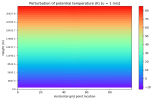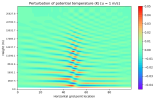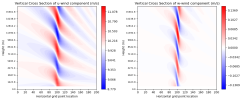Hi all!
I'm playing around with the em_hill2d_x idealized case. In particular, I'd like to reproduce different flow regimes and I started doing this by changing the vertical profile of the wind. I'm having some issues in understanding the output of the simulations when changing the vertical profile of the wind, though.
The base case has the wind set as u=10 m/s, and from the vertical profile of the potential temperature I found that N=0.01 s-1, resulting in the lineary parameter u/Nh = 10, where h is the hill height, and giving the well known linear solution.
However, if I decrease the wind speed to u=1m/s I get something that I don't well understand, as you can see from the attached figures. First of all, I don't understand why the temperature profile remains the same of the linear case, and then I don't understand what happens at the wind profiles, are there some instabilities arising?
The only thing I changed from the namelist.input is the size of the domain in the west-east direction to have it of 101 gridpoints, then I set the resolution to 1 km and changed the time step accordingly to 6. The hill shape is the same as in the default case, with h=100m and half-width to 5 grid points (so half-width at half-height is 10km if I'm correct).
I hope this question is in line with the topic and the forum.
Thank you very much for your help!
I'm playing around with the em_hill2d_x idealized case. In particular, I'd like to reproduce different flow regimes and I started doing this by changing the vertical profile of the wind. I'm having some issues in understanding the output of the simulations when changing the vertical profile of the wind, though.
The base case has the wind set as u=10 m/s, and from the vertical profile of the potential temperature I found that N=0.01 s-1, resulting in the lineary parameter u/Nh = 10, where h is the hill height, and giving the well known linear solution.
However, if I decrease the wind speed to u=1m/s I get something that I don't well understand, as you can see from the attached figures. First of all, I don't understand why the temperature profile remains the same of the linear case, and then I don't understand what happens at the wind profiles, are there some instabilities arising?
The only thing I changed from the namelist.input is the size of the domain in the west-east direction to have it of 101 gridpoints, then I set the resolution to 1 km and changed the time step accordingly to 6. The hill shape is the same as in the default case, with h=100m and half-width to 5 grid points (so half-width at half-height is 10km if I'm correct).
I hope this question is in line with the topic and the forum.
Thank you very much for your help!
Attachments
Last edited:








